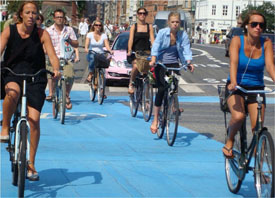In new book, Rutgers’ John Pucher outlines benefits, challenges to biking in cities
One way to raise the overall levels of daily cycling in American cities – a healthy, eco-friendly and convenient way to travel – is to get more women to take up biking.
That is one of the conclusions John Pucher, a professor at Rutgers’ Edward J. Bloustein School of Planning and Public Policy, reaches in his recently published book, City Cycling (MIT Press 2012), a guide to the urban cycling renaissance under way in most countries of the western industrialized world.
City Cycling, co-edited with Ralph Buehler, a Virginia Tech professor of urban affairs and planning, comprises 15 chapters co-authored by 20 of the world’s leading experts in specific areas of cycling research and policy.
The book explores a myriad of topics, including a trans-Atlantic comparison of infrastructure for mass cycling; bicycles and accessories; an analysis of cycling in small, big and megacities (London, Paris, New York and Tokyo); and an evaluation of a wide range of pro-bike policies and programs. .
One chapter, “Women and Cycling” is co-authored by three women professors of urban planning, health and environmental science who find the percentage of women cyclists in a locale to be a bellwether of biking safety and convenience.
Women, the co-authors say, are an “indicator species” for bike-friendly cities. In cities and countries where a high percentage of bike trips are by women, rates of cycling are high, and cycling conditions are safe, convenient and comfortable. Where relatively few women cycle, rates of cycling are low and cycling conditions are unsafe, inconvenient, uncomfortable and sometimes impossible.
“The book’s purpose is not simply to portray trends in cycling but to promote daily cycling in cities and in

all segments of society – including women, children and seniors – and for commonplace trips, such as visiting friends and for travel to work, school, church, doctors’ offices and stores,” says Pucher, an internationally recognized expert on cycling.
The goal seems realistic: 40 percent of all bike trips are two miles or less and 50 percent are three miles or less, according to a U.S. Department of Transportation/Federal Highway Administration study.
Denmark is portrayed as a model of what needs to be done to integrate biking into everyday life. The country is a bastion of cycling, where 18 percent of all trips are made by bike compared with only 1 percent in the U.S. Fifty-five percent of all bike trips by Danes are made by female riders, compared to 24 percent of all bike trips made by women in the U.S.
“If you want to get people on bikes, ask women what they want and give it to them,” Pucher says. He says efforts to make bicycling popular in urban areas require allaying women’s fears about safety issues, while highlighting the enormous health and environmental benefits.
Research shows that women, though less likely to be injured than men, are more likely to perceive biking as unsafe. To get women biking, Pucher says it is essential to target cycling infrastructure and programs to their preferences. “Our findings serve as a reminder that perceptions of risk may be important as actual risks, particularly for women, and that traffic risks extend beyond the risk of fatality or serious injury to include risk of near misses and harassment,” Pucher says.
Cities must create dedicated bike lanes – preferably physically separated from vehicular traffic – that take people to places they want to go. Police enforcement of bike lanes is crucial, as studies find that bike lanes in New York City are blocked by motor vehicles 60 percent of the time, forcing cyclists to swerve in and out of moving traffic or to ride on sidewalks.

In contrast to the situation in New York, where police fail to keep bike lanes unblocked and often harass cyclists, the cooperation of police in Chicago, Portland and San Francisco ensures greater safety for cyclists and pedestrians. Traffic safety training for motorists, cyclists and pedestrians, and stricter enforcement of existing traffic laws, would greatly improve cycling safety and encourage more cycling.
Ample bike parking is also essential, as is sheltered parking during inclement weather.
Pucher and Buehler find that measures introduced comprehensively, gradually and in a mutually re-enforcing way, can lead to successful cycling programs in urban areas – even entire countries – including those where the automobile is unquestionably king. They offer the Netherlands as an example, where the Dutch make 26 percent of all trips via bikes, more than half of those (56 percent) by women.
“Perhaps the most important lesson drawn from case studies is that no single measure suffices,” Pucher says. “A coordinated package of infrastructure provisions, promotional programs, and transportation and land-use policies is the trademark of every city that has succeeded at significantly raising cycling levels and improving safety.”
Key measures to make city cycling a reality include:
- networks of integrated bikeways with advance stop lines and priority signals for cyclists at intersections
- sufficient, secure parking at key destinations and public transportation stations
- buses and trains that allow bikes on board
- improved cyclist education and expanded bike-to-school programs
- stricter motorist training, licensing and traffic enforcement
- land-use policies that favor compact, mixed-use communities with shorter trip distances that can be easily covered by bike
- citizen participation at all stages of the planning process and alliances with politicians, cycling organizations and other bike-friendly groups.